Strategic Management Report: Sun Power Corporation
VerifiedAdded on 2020/03/28
|20
|4269
|155
Report
AI Summary
This report provides a comprehensive strategic analysis of Sun Power Corporation, examining both its external and internal environments. The analysis begins with an overview of the company's stakeholders and then delves into the external environment using PESTLE and Porter's five forces models to identify opportunities and threats. The internal environment is assessed through core competence, value chain analysis (VCA), and SWOT analysis to evaluate the company's strengths, weaknesses, opportunities, and threats. The report further explores mergers and acquisitions, discussing acquisition strategies, mergers/amalgamations, their advantages, disadvantages, and associated risks. Finally, the report analyzes market strategies using the Ansoff matrix, including market penetration, market development, product development, and diversification strategies to understand market potential and growth. References are included to support the analysis.
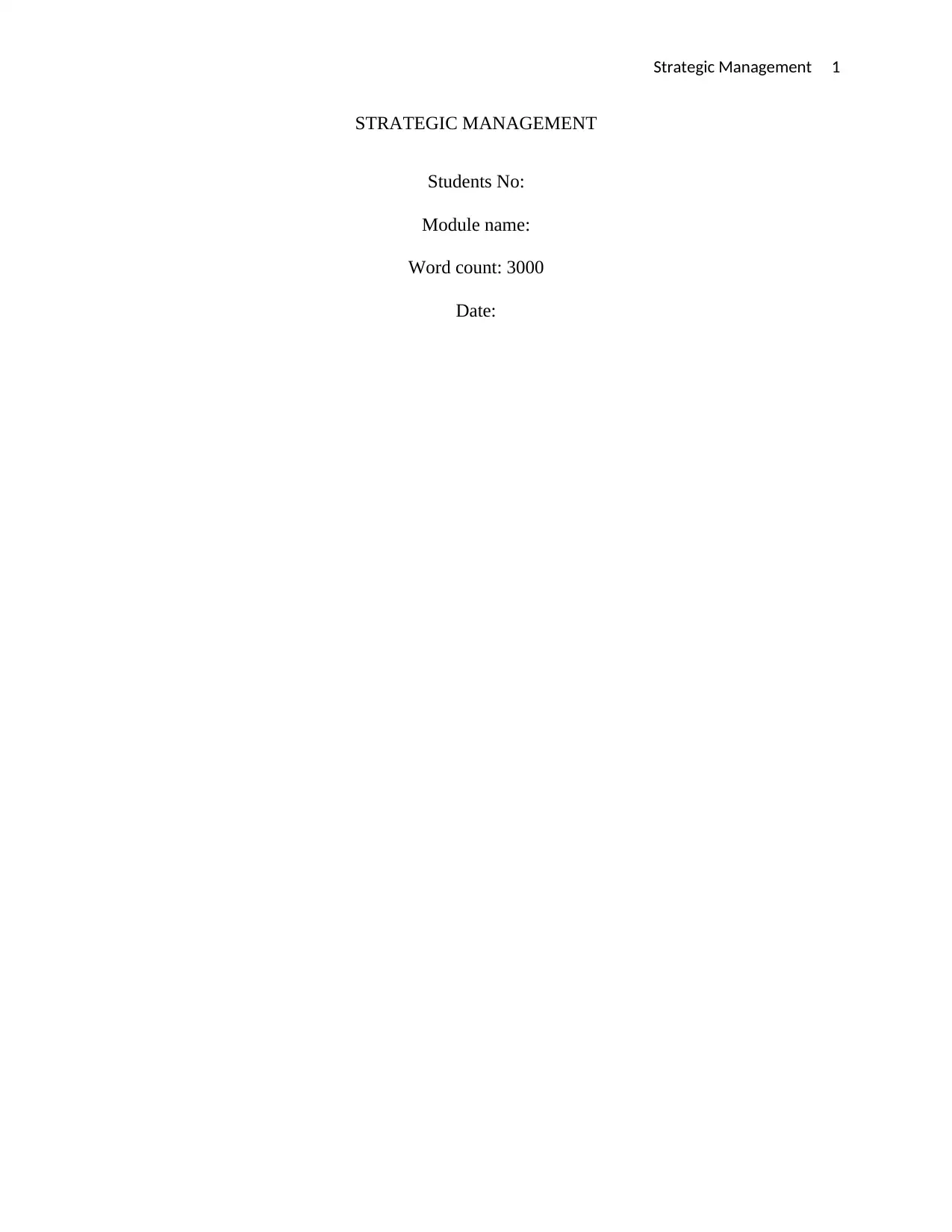
Strategic Management 1
STRATEGIC MANAGEMENT
Students No:
Module name:
Word count: 3000
Date:
STRATEGIC MANAGEMENT
Students No:
Module name:
Word count: 3000
Date:
Paraphrase This Document
Need a fresh take? Get an instant paraphrase of this document with our AI Paraphraser
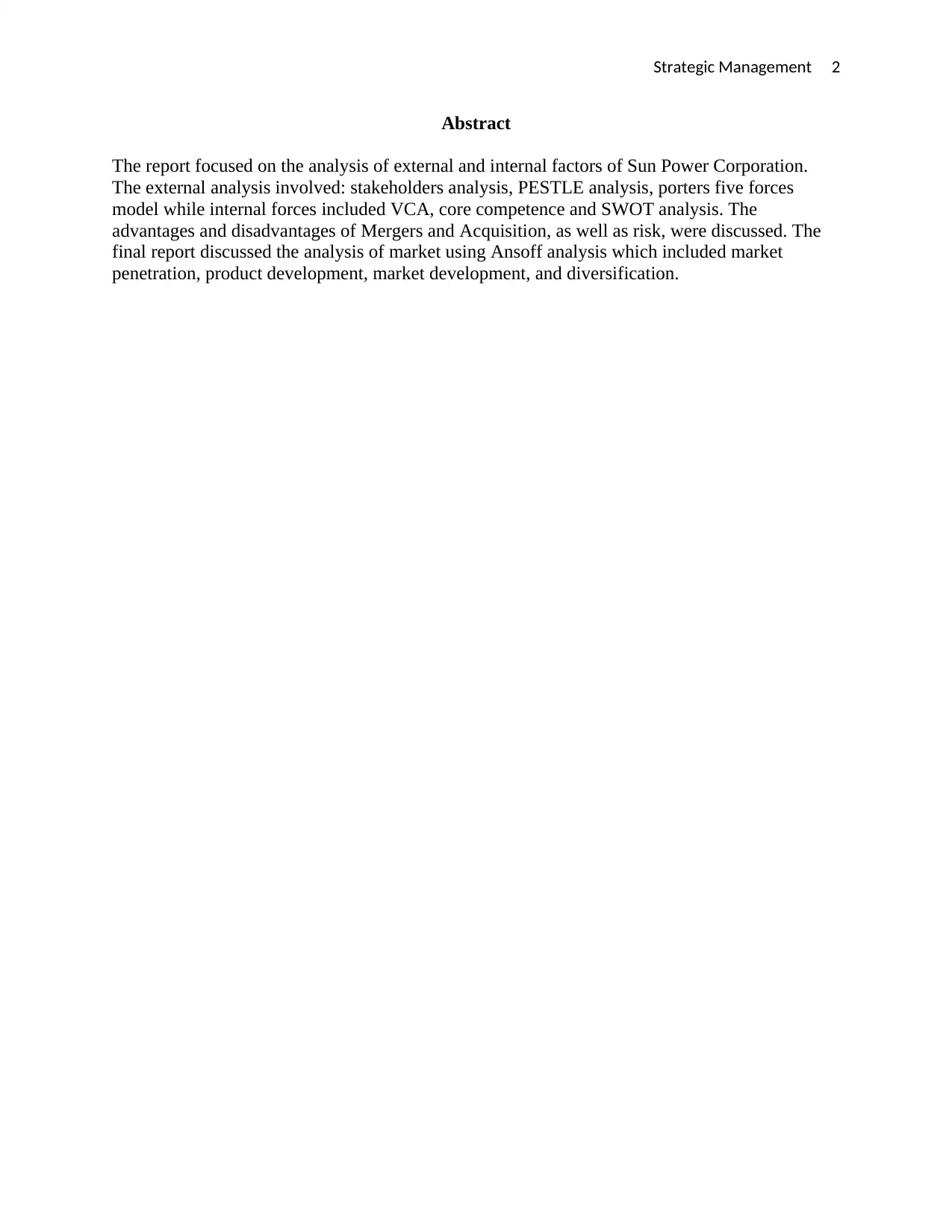
Strategic Management 2
Abstract
The report focused on the analysis of external and internal factors of Sun Power Corporation.
The external analysis involved: stakeholders analysis, PESTLE analysis, porters five forces
model while internal forces included VCA, core competence and SWOT analysis. The
advantages and disadvantages of Mergers and Acquisition, as well as risk, were discussed. The
final report discussed the analysis of market using Ansoff analysis which included market
penetration, product development, market development, and diversification.
Abstract
The report focused on the analysis of external and internal factors of Sun Power Corporation.
The external analysis involved: stakeholders analysis, PESTLE analysis, porters five forces
model while internal forces included VCA, core competence and SWOT analysis. The
advantages and disadvantages of Mergers and Acquisition, as well as risk, were discussed. The
final report discussed the analysis of market using Ansoff analysis which included market
penetration, product development, market development, and diversification.
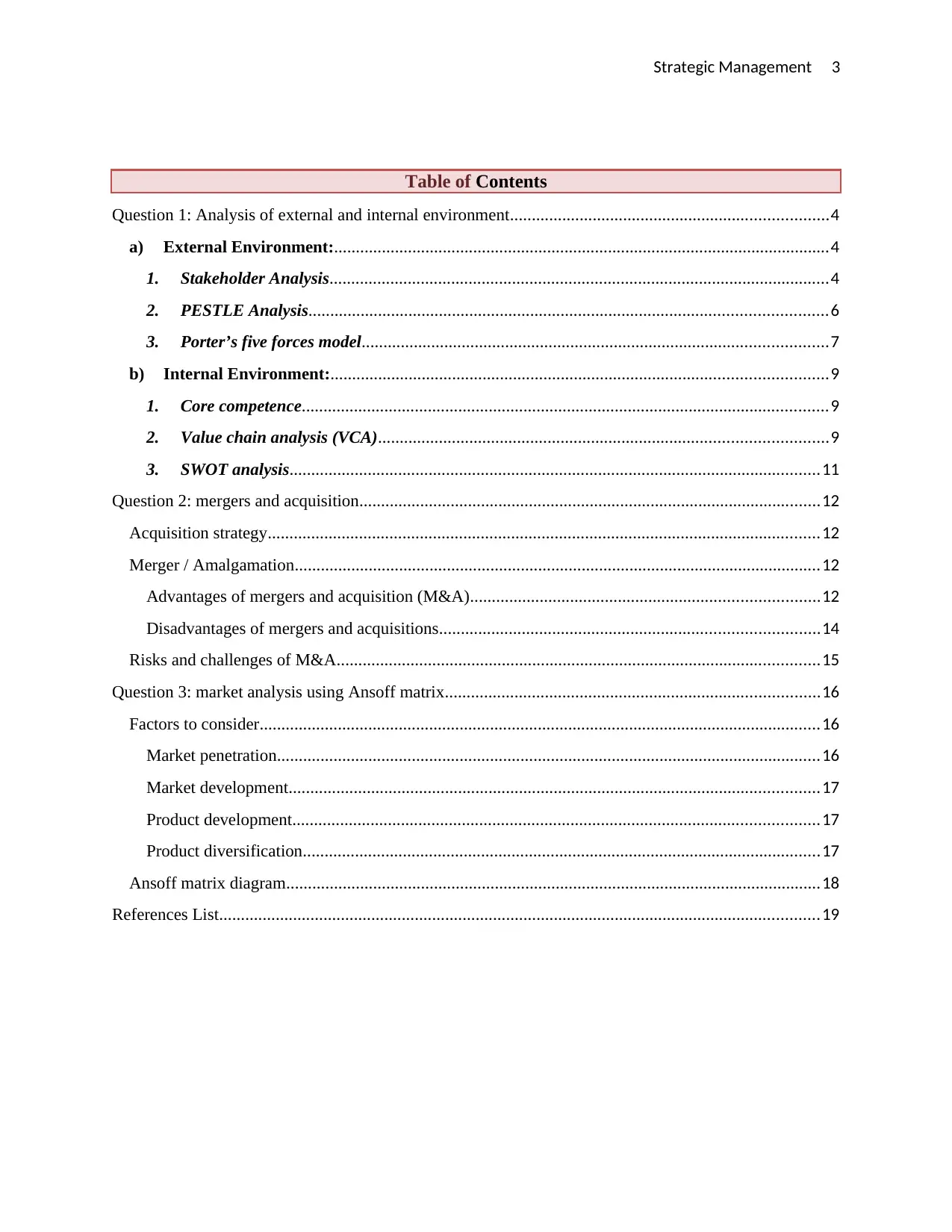
Strategic Management 3
Table of Contents
Question 1: Analysis of external and internal environment.........................................................................4
a) External Environment:..................................................................................................................4
1. Stakeholder Analysis...................................................................................................................4
2. PESTLE Analysis.......................................................................................................................6
3. Porter’s five forces model...........................................................................................................7
b) Internal Environment:..................................................................................................................9
1. Core competence.........................................................................................................................9
2. Value chain analysis (VCA).......................................................................................................9
3. SWOT analysis..........................................................................................................................11
Question 2: mergers and acquisition..........................................................................................................12
Acquisition strategy...............................................................................................................................12
Merger / Amalgamation.........................................................................................................................12
Advantages of mergers and acquisition (M&A)................................................................................12
Disadvantages of mergers and acquisitions.......................................................................................14
Risks and challenges of M&A...............................................................................................................15
Question 3: market analysis using Ansoff matrix......................................................................................16
Factors to consider.................................................................................................................................16
Market penetration.............................................................................................................................16
Market development..........................................................................................................................17
Product development.........................................................................................................................17
Product diversification.......................................................................................................................17
Ansoff matrix diagram...........................................................................................................................18
References List..........................................................................................................................................19
Table of Contents
Question 1: Analysis of external and internal environment.........................................................................4
a) External Environment:..................................................................................................................4
1. Stakeholder Analysis...................................................................................................................4
2. PESTLE Analysis.......................................................................................................................6
3. Porter’s five forces model...........................................................................................................7
b) Internal Environment:..................................................................................................................9
1. Core competence.........................................................................................................................9
2. Value chain analysis (VCA).......................................................................................................9
3. SWOT analysis..........................................................................................................................11
Question 2: mergers and acquisition..........................................................................................................12
Acquisition strategy...............................................................................................................................12
Merger / Amalgamation.........................................................................................................................12
Advantages of mergers and acquisition (M&A)................................................................................12
Disadvantages of mergers and acquisitions.......................................................................................14
Risks and challenges of M&A...............................................................................................................15
Question 3: market analysis using Ansoff matrix......................................................................................16
Factors to consider.................................................................................................................................16
Market penetration.............................................................................................................................16
Market development..........................................................................................................................17
Product development.........................................................................................................................17
Product diversification.......................................................................................................................17
Ansoff matrix diagram...........................................................................................................................18
References List..........................................................................................................................................19
⊘ This is a preview!⊘
Do you want full access?
Subscribe today to unlock all pages.

Trusted by 1+ million students worldwide
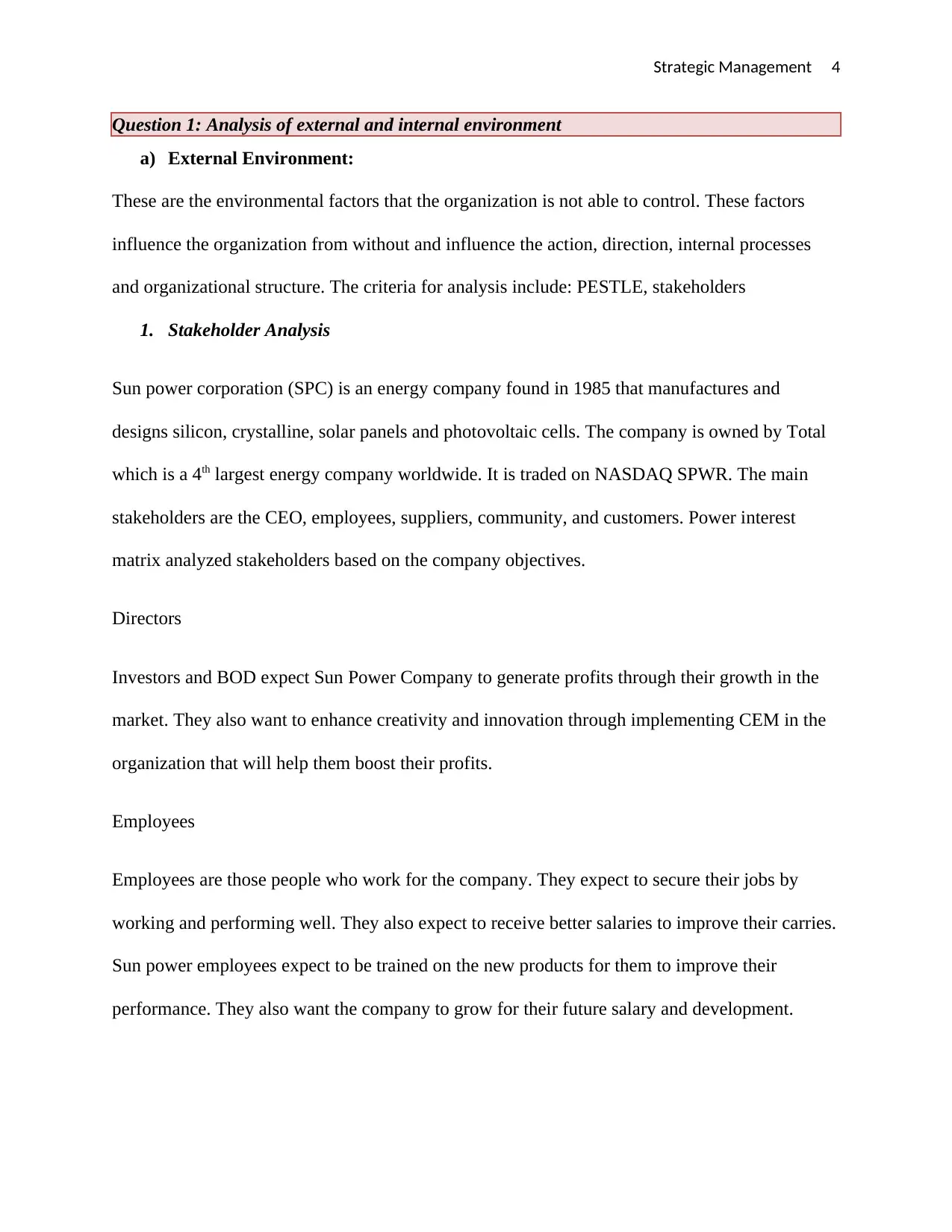
Strategic Management 4
Question 1: Analysis of external and internal environment
a) External Environment:
These are the environmental factors that the organization is not able to control. These factors
influence the organization from without and influence the action, direction, internal processes
and organizational structure. The criteria for analysis include: PESTLE, stakeholders
1. Stakeholder Analysis
Sun power corporation (SPC) is an energy company found in 1985 that manufactures and
designs silicon, crystalline, solar panels and photovoltaic cells. The company is owned by Total
which is a 4th largest energy company worldwide. It is traded on NASDAQ SPWR. The main
stakeholders are the CEO, employees, suppliers, community, and customers. Power interest
matrix analyzed stakeholders based on the company objectives.
Directors
Investors and BOD expect Sun Power Company to generate profits through their growth in the
market. They also want to enhance creativity and innovation through implementing CEM in the
organization that will help them boost their profits.
Employees
Employees are those people who work for the company. They expect to secure their jobs by
working and performing well. They also expect to receive better salaries to improve their carries.
Sun power employees expect to be trained on the new products for them to improve their
performance. They also want the company to grow for their future salary and development.
Question 1: Analysis of external and internal environment
a) External Environment:
These are the environmental factors that the organization is not able to control. These factors
influence the organization from without and influence the action, direction, internal processes
and organizational structure. The criteria for analysis include: PESTLE, stakeholders
1. Stakeholder Analysis
Sun power corporation (SPC) is an energy company found in 1985 that manufactures and
designs silicon, crystalline, solar panels and photovoltaic cells. The company is owned by Total
which is a 4th largest energy company worldwide. It is traded on NASDAQ SPWR. The main
stakeholders are the CEO, employees, suppliers, community, and customers. Power interest
matrix analyzed stakeholders based on the company objectives.
Directors
Investors and BOD expect Sun Power Company to generate profits through their growth in the
market. They also want to enhance creativity and innovation through implementing CEM in the
organization that will help them boost their profits.
Employees
Employees are those people who work for the company. They expect to secure their jobs by
working and performing well. They also expect to receive better salaries to improve their carries.
Sun power employees expect to be trained on the new products for them to improve their
performance. They also want the company to grow for their future salary and development.
Paraphrase This Document
Need a fresh take? Get an instant paraphrase of this document with our AI Paraphraser
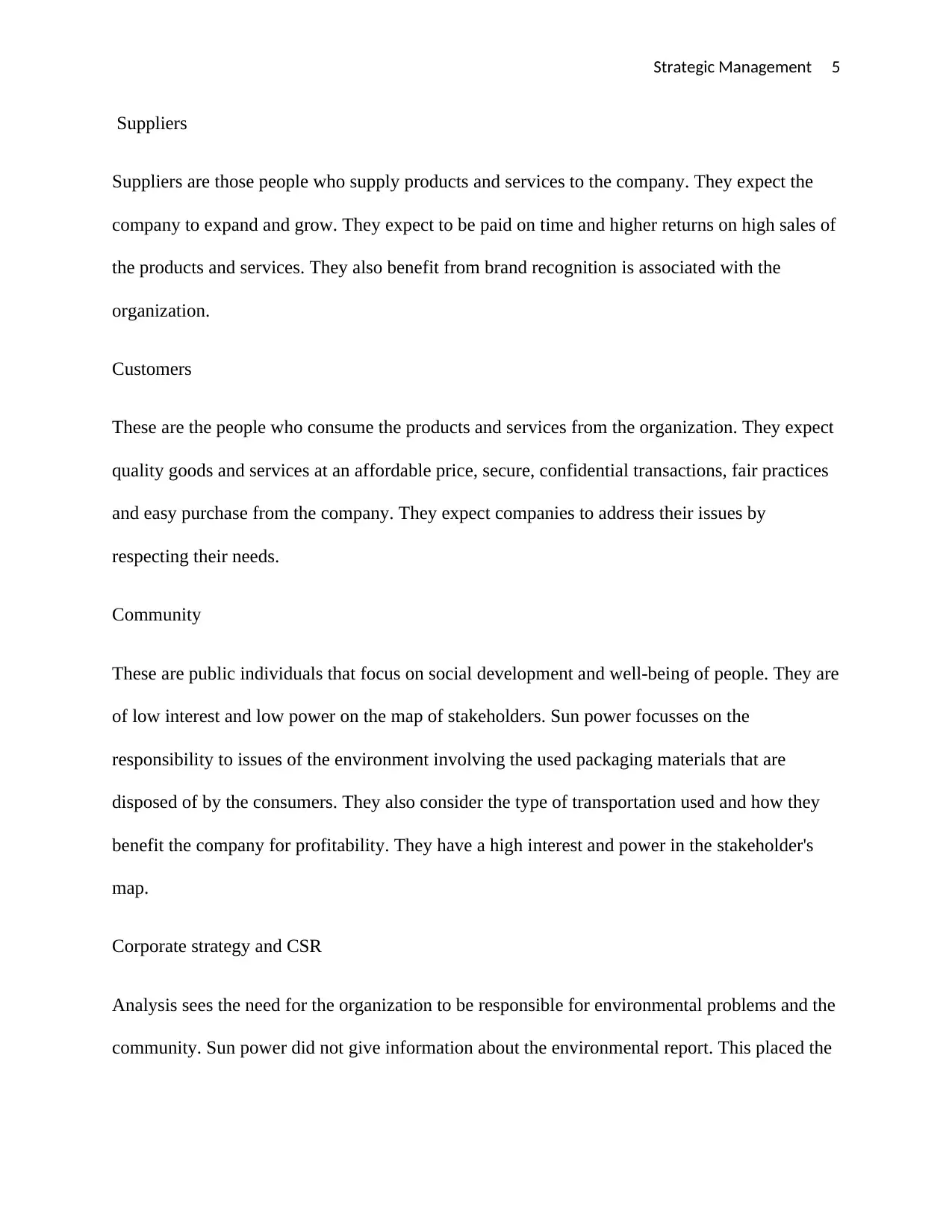
Strategic Management 5
Suppliers
Suppliers are those people who supply products and services to the company. They expect the
company to expand and grow. They expect to be paid on time and higher returns on high sales of
the products and services. They also benefit from brand recognition is associated with the
organization.
Customers
These are the people who consume the products and services from the organization. They expect
quality goods and services at an affordable price, secure, confidential transactions, fair practices
and easy purchase from the company. They expect companies to address their issues by
respecting their needs.
Community
These are public individuals that focus on social development and well-being of people. They are
of low interest and low power on the map of stakeholders. Sun power focusses on the
responsibility to issues of the environment involving the used packaging materials that are
disposed of by the consumers. They also consider the type of transportation used and how they
benefit the company for profitability. They have a high interest and power in the stakeholder's
map.
Corporate strategy and CSR
Analysis sees the need for the organization to be responsible for environmental problems and the
community. Sun power did not give information about the environmental report. This placed the
Suppliers
Suppliers are those people who supply products and services to the company. They expect the
company to expand and grow. They expect to be paid on time and higher returns on high sales of
the products and services. They also benefit from brand recognition is associated with the
organization.
Customers
These are the people who consume the products and services from the organization. They expect
quality goods and services at an affordable price, secure, confidential transactions, fair practices
and easy purchase from the company. They expect companies to address their issues by
respecting their needs.
Community
These are public individuals that focus on social development and well-being of people. They are
of low interest and low power on the map of stakeholders. Sun power focusses on the
responsibility to issues of the environment involving the used packaging materials that are
disposed of by the consumers. They also consider the type of transportation used and how they
benefit the company for profitability. They have a high interest and power in the stakeholder's
map.
Corporate strategy and CSR
Analysis sees the need for the organization to be responsible for environmental problems and the
community. Sun power did not give information about the environmental report. This placed the
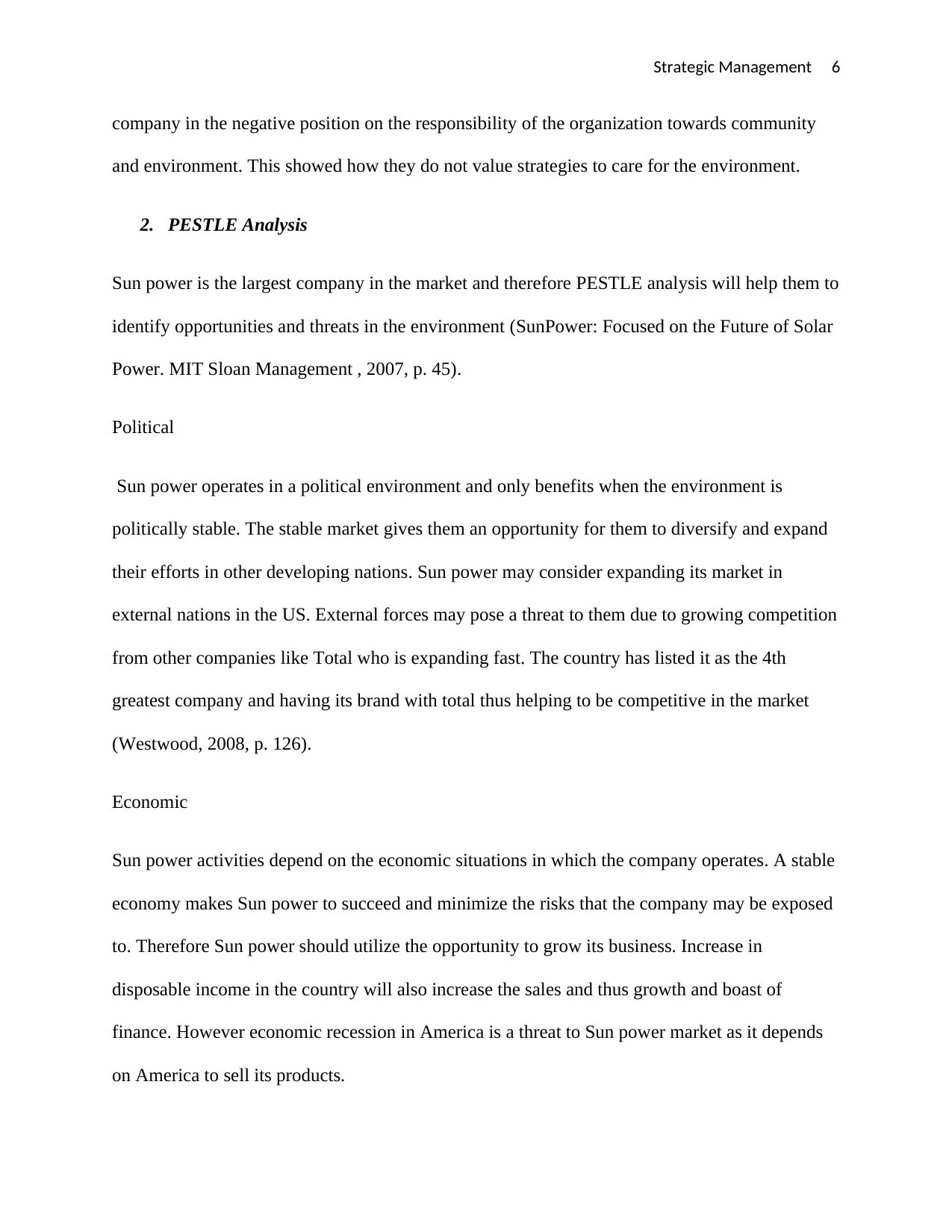
Strategic Management 6
company in the negative position on the responsibility of the organization towards community
and environment. This showed how they do not value strategies to care for the environment.
2. PESTLE Analysis
Sun power is the largest company in the market and therefore PESTLE analysis will help them to
identify opportunities and threats in the environment (SunPower: Focused on the Future of Solar
Power. MIT Sloan Management , 2007, p. 45).
Political
Sun power operates in a political environment and only benefits when the environment is
politically stable. The stable market gives them an opportunity for them to diversify and expand
their efforts in other developing nations. Sun power may consider expanding its market in
external nations in the US. External forces may pose a threat to them due to growing competition
from other companies like Total who is expanding fast. The country has listed it as the 4th
greatest company and having its brand with total thus helping to be competitive in the market
(Westwood, 2008, p. 126).
Economic
Sun power activities depend on the economic situations in which the company operates. A stable
economy makes Sun power to succeed and minimize the risks that the company may be exposed
to. Therefore Sun power should utilize the opportunity to grow its business. Increase in
disposable income in the country will also increase the sales and thus growth and boast of
finance. However economic recession in America is a threat to Sun power market as it depends
on America to sell its products.
company in the negative position on the responsibility of the organization towards community
and environment. This showed how they do not value strategies to care for the environment.
2. PESTLE Analysis
Sun power is the largest company in the market and therefore PESTLE analysis will help them to
identify opportunities and threats in the environment (SunPower: Focused on the Future of Solar
Power. MIT Sloan Management , 2007, p. 45).
Political
Sun power operates in a political environment and only benefits when the environment is
politically stable. The stable market gives them an opportunity for them to diversify and expand
their efforts in other developing nations. Sun power may consider expanding its market in
external nations in the US. External forces may pose a threat to them due to growing competition
from other companies like Total who is expanding fast. The country has listed it as the 4th
greatest company and having its brand with total thus helping to be competitive in the market
(Westwood, 2008, p. 126).
Economic
Sun power activities depend on the economic situations in which the company operates. A stable
economy makes Sun power to succeed and minimize the risks that the company may be exposed
to. Therefore Sun power should utilize the opportunity to grow its business. Increase in
disposable income in the country will also increase the sales and thus growth and boast of
finance. However economic recession in America is a threat to Sun power market as it depends
on America to sell its products.
⊘ This is a preview!⊘
Do you want full access?
Subscribe today to unlock all pages.

Trusted by 1+ million students worldwide
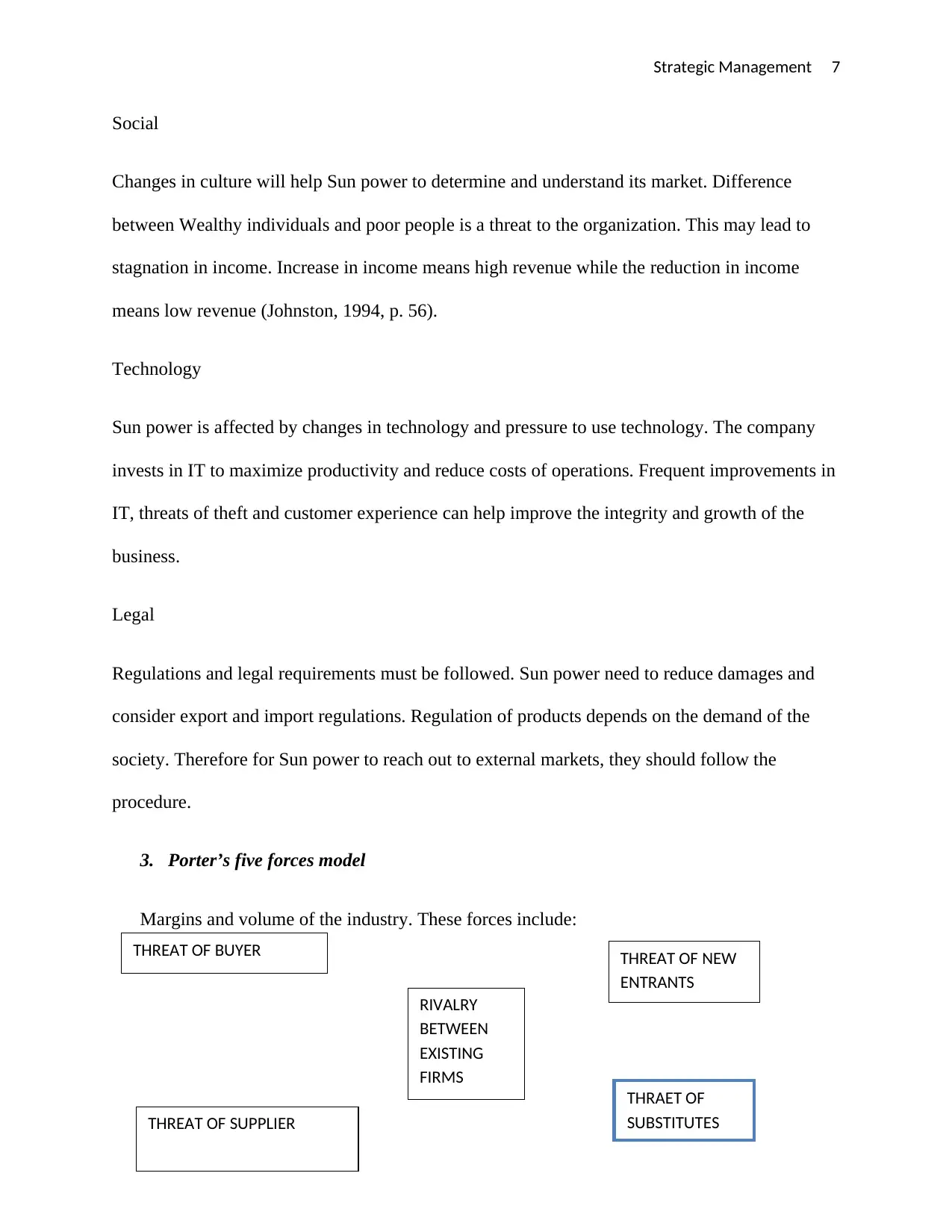
Strategic Management 7
Social
Changes in culture will help Sun power to determine and understand its market. Difference
between Wealthy individuals and poor people is a threat to the organization. This may lead to
stagnation in income. Increase in income means high revenue while the reduction in income
means low revenue (Johnston, 1994, p. 56).
Technology
Sun power is affected by changes in technology and pressure to use technology. The company
invests in IT to maximize productivity and reduce costs of operations. Frequent improvements in
IT, threats of theft and customer experience can help improve the integrity and growth of the
business.
Legal
Regulations and legal requirements must be followed. Sun power need to reduce damages and
consider export and import regulations. Regulation of products depends on the demand of the
society. Therefore for Sun power to reach out to external markets, they should follow the
procedure.
3. Porter’s five forces model
Margins and volume of the industry. These forces include:
4.
THREAT OF BUYER THREAT OF NEW
ENTRANTS
THREAT OF SUPPLIER
THRAET OF
SUBSTITUTES
RIVALRY
BETWEEN
EXISTING
FIRMS
Social
Changes in culture will help Sun power to determine and understand its market. Difference
between Wealthy individuals and poor people is a threat to the organization. This may lead to
stagnation in income. Increase in income means high revenue while the reduction in income
means low revenue (Johnston, 1994, p. 56).
Technology
Sun power is affected by changes in technology and pressure to use technology. The company
invests in IT to maximize productivity and reduce costs of operations. Frequent improvements in
IT, threats of theft and customer experience can help improve the integrity and growth of the
business.
Legal
Regulations and legal requirements must be followed. Sun power need to reduce damages and
consider export and import regulations. Regulation of products depends on the demand of the
society. Therefore for Sun power to reach out to external markets, they should follow the
procedure.
3. Porter’s five forces model
Margins and volume of the industry. These forces include:
4.
THREAT OF BUYER THREAT OF NEW
ENTRANTS
THREAT OF SUPPLIER
THRAET OF
SUBSTITUTES
RIVALRY
BETWEEN
EXISTING
FIRMS
Paraphrase This Document
Need a fresh take? Get an instant paraphrase of this document with our AI Paraphraser
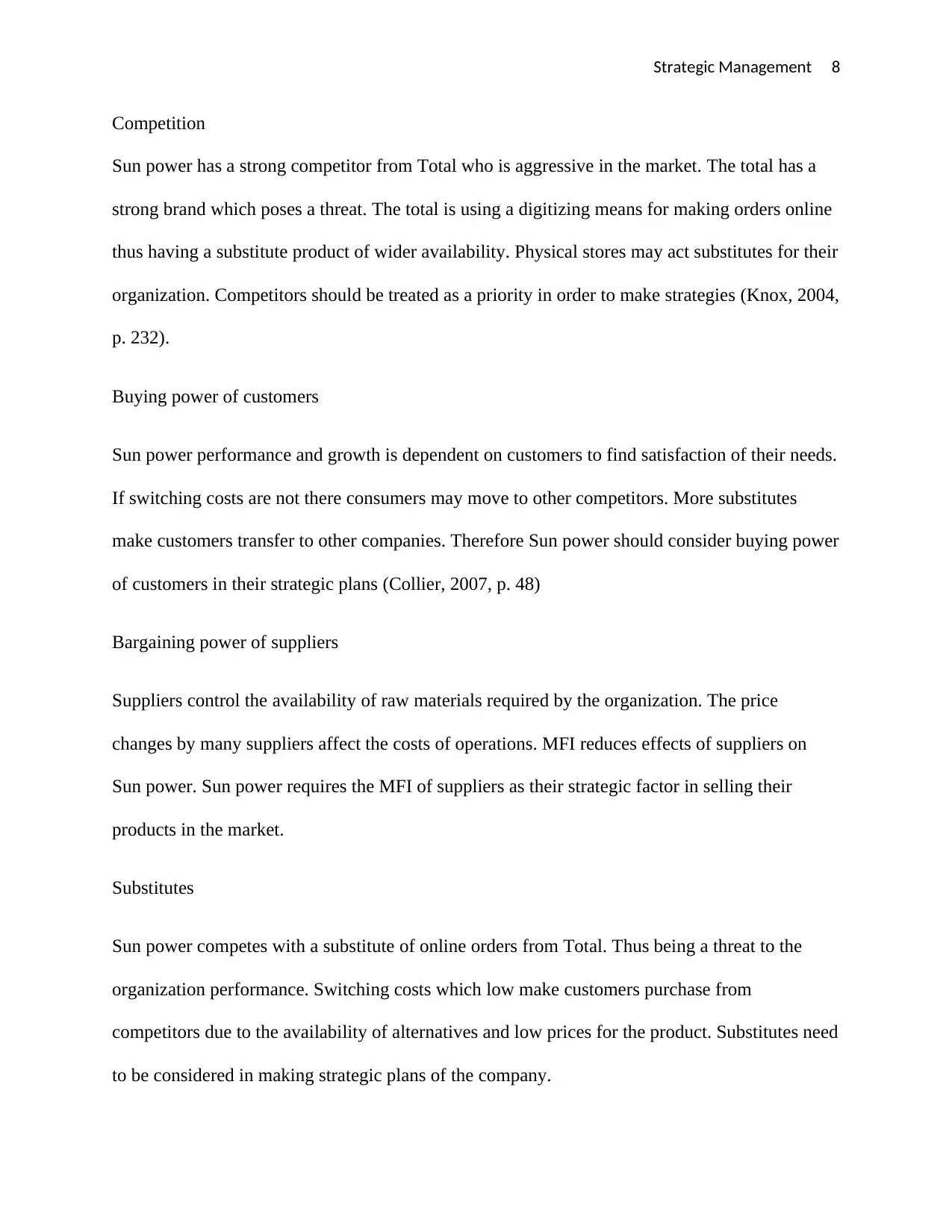
Strategic Management 8
Competition
Sun power has a strong competitor from Total who is aggressive in the market. The total has a
strong brand which poses a threat. The total is using a digitizing means for making orders online
thus having a substitute product of wider availability. Physical stores may act substitutes for their
organization. Competitors should be treated as a priority in order to make strategies (Knox, 2004,
p. 232).
Buying power of customers
Sun power performance and growth is dependent on customers to find satisfaction of their needs.
If switching costs are not there consumers may move to other competitors. More substitutes
make customers transfer to other companies. Therefore Sun power should consider buying power
of customers in their strategic plans (Collier, 2007, p. 48)
Bargaining power of suppliers
Suppliers control the availability of raw materials required by the organization. The price
changes by many suppliers affect the costs of operations. MFI reduces effects of suppliers on
Sun power. Sun power requires the MFI of suppliers as their strategic factor in selling their
products in the market.
Substitutes
Sun power competes with a substitute of online orders from Total. Thus being a threat to the
organization performance. Switching costs which low make customers purchase from
competitors due to the availability of alternatives and low prices for the product. Substitutes need
to be considered in making strategic plans of the company.
Competition
Sun power has a strong competitor from Total who is aggressive in the market. The total has a
strong brand which poses a threat. The total is using a digitizing means for making orders online
thus having a substitute product of wider availability. Physical stores may act substitutes for their
organization. Competitors should be treated as a priority in order to make strategies (Knox, 2004,
p. 232).
Buying power of customers
Sun power performance and growth is dependent on customers to find satisfaction of their needs.
If switching costs are not there consumers may move to other competitors. More substitutes
make customers transfer to other companies. Therefore Sun power should consider buying power
of customers in their strategic plans (Collier, 2007, p. 48)
Bargaining power of suppliers
Suppliers control the availability of raw materials required by the organization. The price
changes by many suppliers affect the costs of operations. MFI reduces effects of suppliers on
Sun power. Sun power requires the MFI of suppliers as their strategic factor in selling their
products in the market.
Substitutes
Sun power competes with a substitute of online orders from Total. Thus being a threat to the
organization performance. Switching costs which low make customers purchase from
competitors due to the availability of alternatives and low prices for the product. Substitutes need
to be considered in making strategic plans of the company.
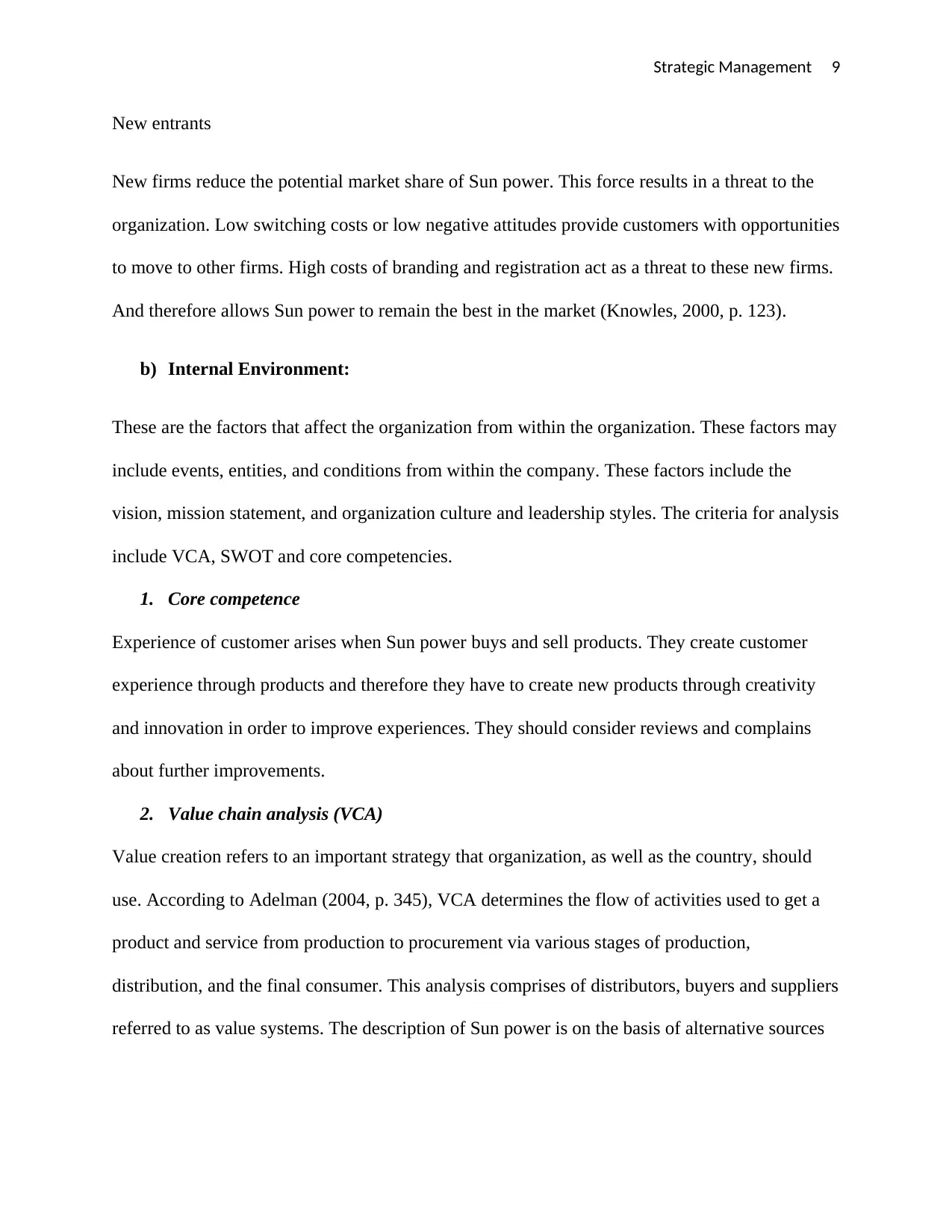
Strategic Management 9
New entrants
New firms reduce the potential market share of Sun power. This force results in a threat to the
organization. Low switching costs or low negative attitudes provide customers with opportunities
to move to other firms. High costs of branding and registration act as a threat to these new firms.
And therefore allows Sun power to remain the best in the market (Knowles, 2000, p. 123).
b) Internal Environment:
These are the factors that affect the organization from within the organization. These factors may
include events, entities, and conditions from within the company. These factors include the
vision, mission statement, and organization culture and leadership styles. The criteria for analysis
include VCA, SWOT and core competencies.
1. Core competence
Experience of customer arises when Sun power buys and sell products. They create customer
experience through products and therefore they have to create new products through creativity
and innovation in order to improve experiences. They should consider reviews and complains
about further improvements.
2. Value chain analysis (VCA)
Value creation refers to an important strategy that organization, as well as the country, should
use. According to Adelman (2004, p. 345), VCA determines the flow of activities used to get a
product and service from production to procurement via various stages of production,
distribution, and the final consumer. This analysis comprises of distributors, buyers and suppliers
referred to as value systems. The description of Sun power is on the basis of alternative sources
New entrants
New firms reduce the potential market share of Sun power. This force results in a threat to the
organization. Low switching costs or low negative attitudes provide customers with opportunities
to move to other firms. High costs of branding and registration act as a threat to these new firms.
And therefore allows Sun power to remain the best in the market (Knowles, 2000, p. 123).
b) Internal Environment:
These are the factors that affect the organization from within the organization. These factors may
include events, entities, and conditions from within the company. These factors include the
vision, mission statement, and organization culture and leadership styles. The criteria for analysis
include VCA, SWOT and core competencies.
1. Core competence
Experience of customer arises when Sun power buys and sell products. They create customer
experience through products and therefore they have to create new products through creativity
and innovation in order to improve experiences. They should consider reviews and complains
about further improvements.
2. Value chain analysis (VCA)
Value creation refers to an important strategy that organization, as well as the country, should
use. According to Adelman (2004, p. 345), VCA determines the flow of activities used to get a
product and service from production to procurement via various stages of production,
distribution, and the final consumer. This analysis comprises of distributors, buyers and suppliers
referred to as value systems. The description of Sun power is on the basis of alternative sources
⊘ This is a preview!⊘
Do you want full access?
Subscribe today to unlock all pages.

Trusted by 1+ million students worldwide
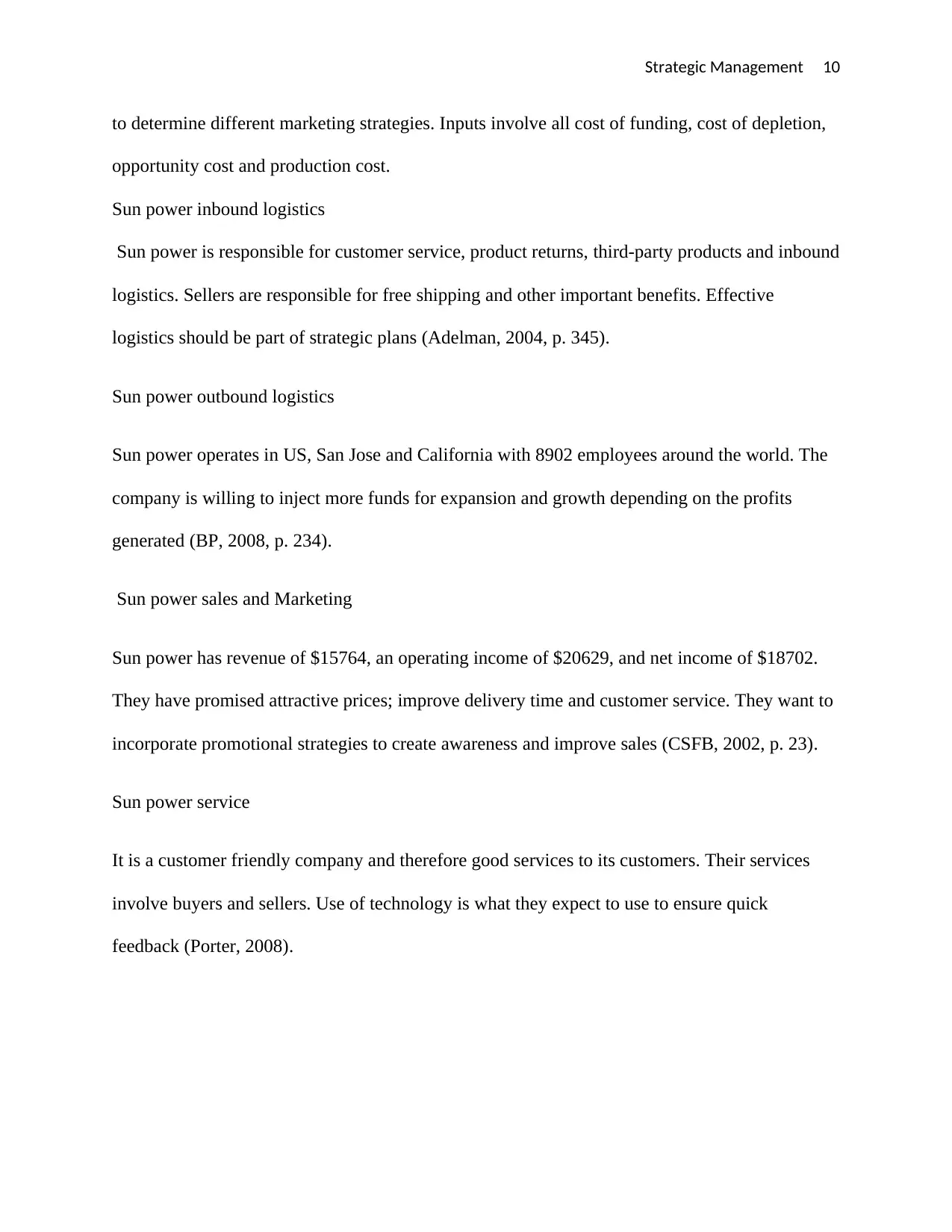
Strategic Management 10
to determine different marketing strategies. Inputs involve all cost of funding, cost of depletion,
opportunity cost and production cost.
Sun power inbound logistics
Sun power is responsible for customer service, product returns, third-party products and inbound
logistics. Sellers are responsible for free shipping and other important benefits. Effective
logistics should be part of strategic plans (Adelman, 2004, p. 345).
Sun power outbound logistics
Sun power operates in US, San Jose and California with 8902 employees around the world. The
company is willing to inject more funds for expansion and growth depending on the profits
generated (BP, 2008, p. 234).
Sun power sales and Marketing
Sun power has revenue of $15764, an operating income of $20629, and net income of $18702.
They have promised attractive prices; improve delivery time and customer service. They want to
incorporate promotional strategies to create awareness and improve sales (CSFB, 2002, p. 23).
Sun power service
It is a customer friendly company and therefore good services to its customers. Their services
involve buyers and sellers. Use of technology is what they expect to use to ensure quick
feedback (Porter, 2008).
to determine different marketing strategies. Inputs involve all cost of funding, cost of depletion,
opportunity cost and production cost.
Sun power inbound logistics
Sun power is responsible for customer service, product returns, third-party products and inbound
logistics. Sellers are responsible for free shipping and other important benefits. Effective
logistics should be part of strategic plans (Adelman, 2004, p. 345).
Sun power outbound logistics
Sun power operates in US, San Jose and California with 8902 employees around the world. The
company is willing to inject more funds for expansion and growth depending on the profits
generated (BP, 2008, p. 234).
Sun power sales and Marketing
Sun power has revenue of $15764, an operating income of $20629, and net income of $18702.
They have promised attractive prices; improve delivery time and customer service. They want to
incorporate promotional strategies to create awareness and improve sales (CSFB, 2002, p. 23).
Sun power service
It is a customer friendly company and therefore good services to its customers. Their services
involve buyers and sellers. Use of technology is what they expect to use to ensure quick
feedback (Porter, 2008).
Paraphrase This Document
Need a fresh take? Get an instant paraphrase of this document with our AI Paraphraser
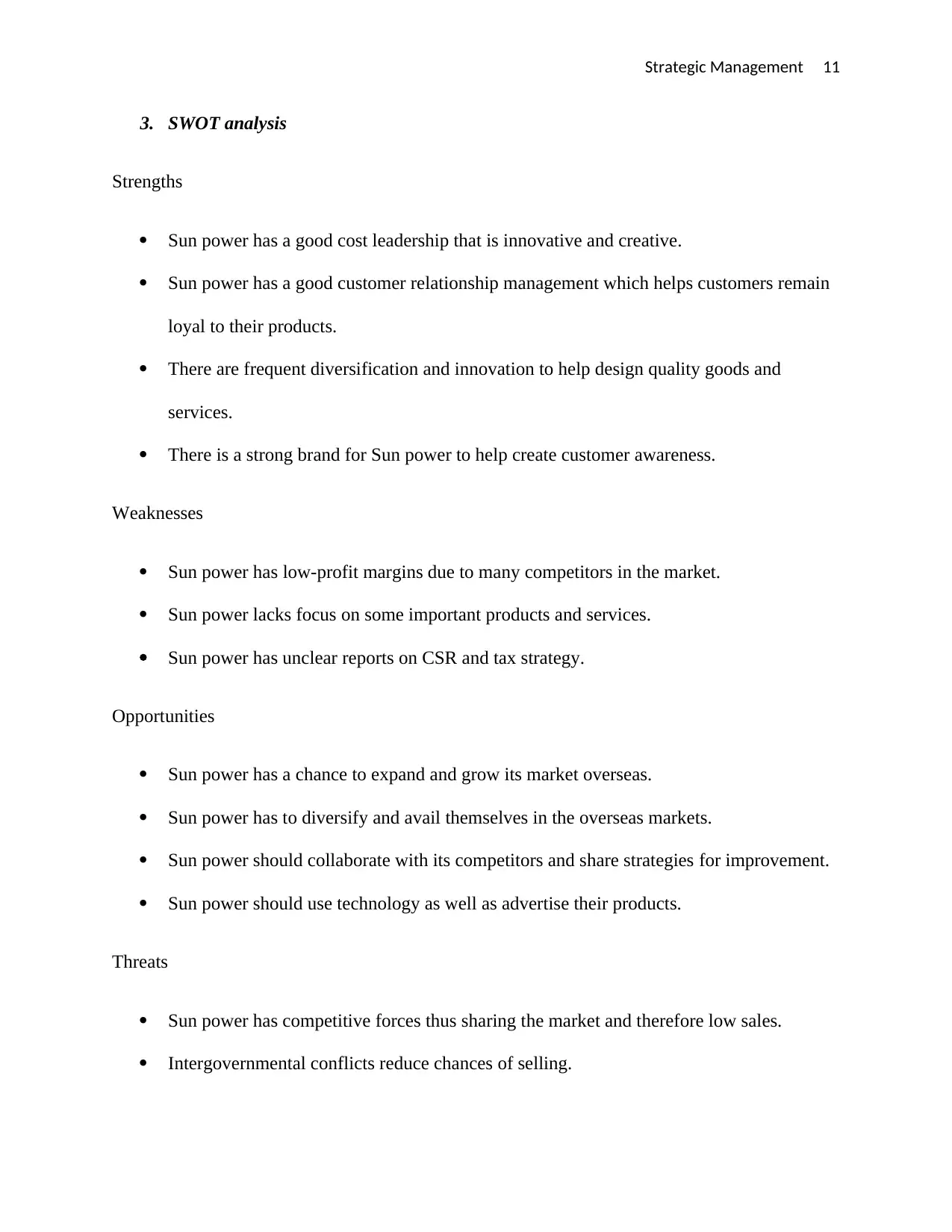
Strategic Management 11
3. SWOT analysis
Strengths
Sun power has a good cost leadership that is innovative and creative.
Sun power has a good customer relationship management which helps customers remain
loyal to their products.
There are frequent diversification and innovation to help design quality goods and
services.
There is a strong brand for Sun power to help create customer awareness.
Weaknesses
Sun power has low-profit margins due to many competitors in the market.
Sun power lacks focus on some important products and services.
Sun power has unclear reports on CSR and tax strategy.
Opportunities
Sun power has a chance to expand and grow its market overseas.
Sun power has to diversify and avail themselves in the overseas markets.
Sun power should collaborate with its competitors and share strategies for improvement.
Sun power should use technology as well as advertise their products.
Threats
Sun power has competitive forces thus sharing the market and therefore low sales.
Intergovernmental conflicts reduce chances of selling.
3. SWOT analysis
Strengths
Sun power has a good cost leadership that is innovative and creative.
Sun power has a good customer relationship management which helps customers remain
loyal to their products.
There are frequent diversification and innovation to help design quality goods and
services.
There is a strong brand for Sun power to help create customer awareness.
Weaknesses
Sun power has low-profit margins due to many competitors in the market.
Sun power lacks focus on some important products and services.
Sun power has unclear reports on CSR and tax strategy.
Opportunities
Sun power has a chance to expand and grow its market overseas.
Sun power has to diversify and avail themselves in the overseas markets.
Sun power should collaborate with its competitors and share strategies for improvement.
Sun power should use technology as well as advertise their products.
Threats
Sun power has competitive forces thus sharing the market and therefore low sales.
Intergovernmental conflicts reduce chances of selling.
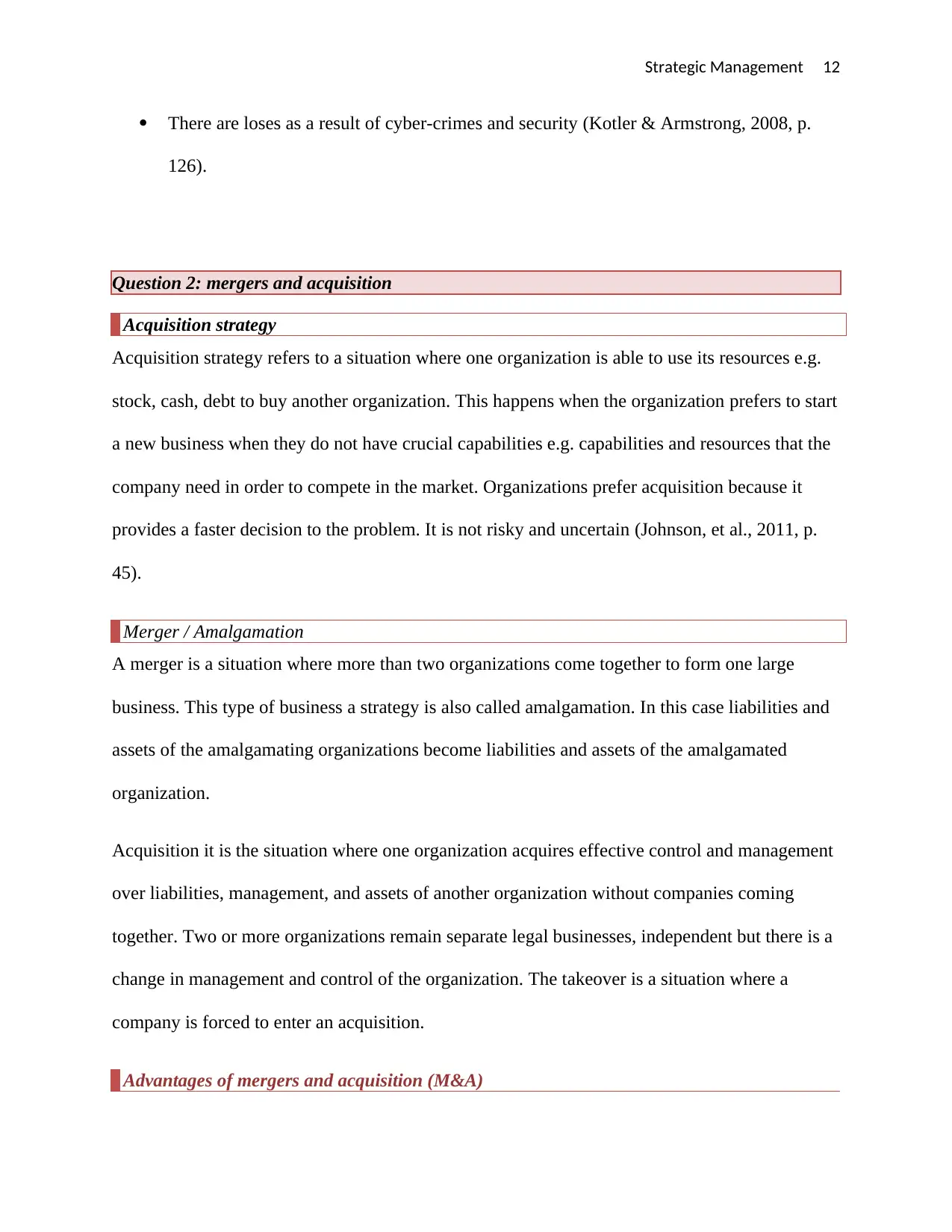
Strategic Management 12
There are loses as a result of cyber-crimes and security (Kotler & Armstrong, 2008, p.
126).
Question 2: mergers and acquisition
Acquisition strategy
Acquisition strategy refers to a situation where one organization is able to use its resources e.g.
stock, cash, debt to buy another organization. This happens when the organization prefers to start
a new business when they do not have crucial capabilities e.g. capabilities and resources that the
company need in order to compete in the market. Organizations prefer acquisition because it
provides a faster decision to the problem. It is not risky and uncertain (Johnson, et al., 2011, p.
45).
Merger / Amalgamation
A merger is a situation where more than two organizations come together to form one large
business. This type of business a strategy is also called amalgamation. In this case liabilities and
assets of the amalgamating organizations become liabilities and assets of the amalgamated
organization.
Acquisition it is the situation where one organization acquires effective control and management
over liabilities, management, and assets of another organization without companies coming
together. Two or more organizations remain separate legal businesses, independent but there is a
change in management and control of the organization. The takeover is a situation where a
company is forced to enter an acquisition.
Advantages of mergers and acquisition (M&A)
There are loses as a result of cyber-crimes and security (Kotler & Armstrong, 2008, p.
126).
Question 2: mergers and acquisition
Acquisition strategy
Acquisition strategy refers to a situation where one organization is able to use its resources e.g.
stock, cash, debt to buy another organization. This happens when the organization prefers to start
a new business when they do not have crucial capabilities e.g. capabilities and resources that the
company need in order to compete in the market. Organizations prefer acquisition because it
provides a faster decision to the problem. It is not risky and uncertain (Johnson, et al., 2011, p.
45).
Merger / Amalgamation
A merger is a situation where more than two organizations come together to form one large
business. This type of business a strategy is also called amalgamation. In this case liabilities and
assets of the amalgamating organizations become liabilities and assets of the amalgamated
organization.
Acquisition it is the situation where one organization acquires effective control and management
over liabilities, management, and assets of another organization without companies coming
together. Two or more organizations remain separate legal businesses, independent but there is a
change in management and control of the organization. The takeover is a situation where a
company is forced to enter an acquisition.
Advantages of mergers and acquisition (M&A)
⊘ This is a preview!⊘
Do you want full access?
Subscribe today to unlock all pages.

Trusted by 1+ million students worldwide
1 out of 20
Related Documents
Your All-in-One AI-Powered Toolkit for Academic Success.
+13062052269
info@desklib.com
Available 24*7 on WhatsApp / Email
![[object Object]](/_next/static/media/star-bottom.7253800d.svg)
Unlock your academic potential
Copyright © 2020–2025 A2Z Services. All Rights Reserved. Developed and managed by ZUCOL.





